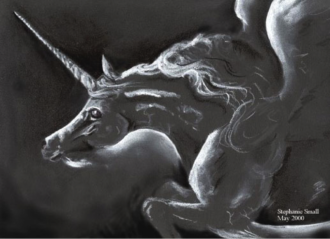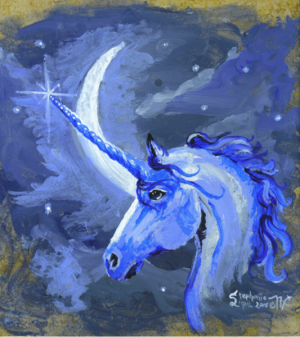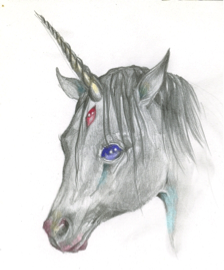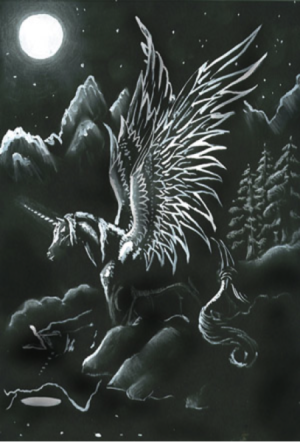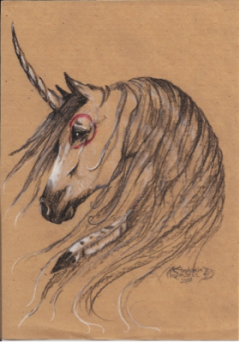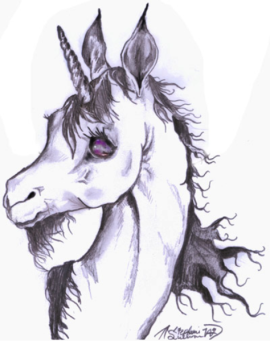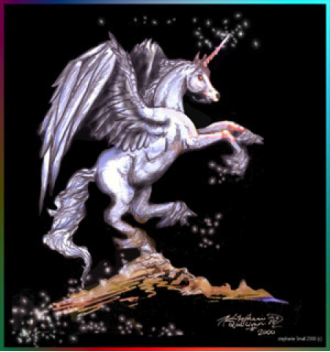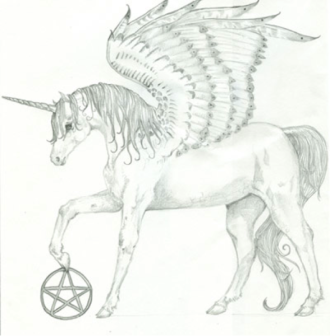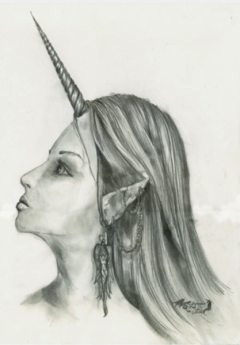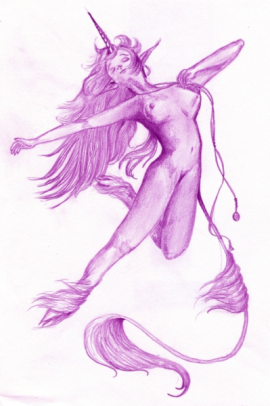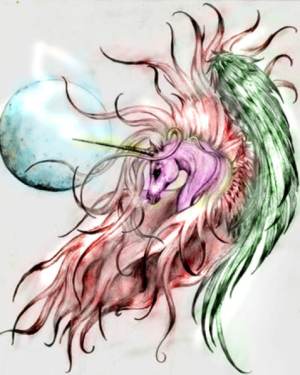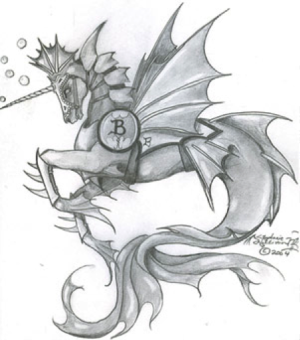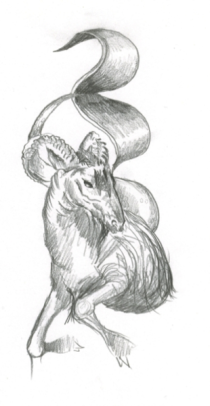
History of the Unicorn
Between 1550 and 1700 there were published about twenty-five extended discussions of the unicorn, ranging from long chapters or separate tracts to whole books.
-Odell Shepard, Lore of the Unicorn
Timeline (and where the unicorn fits in)
This includes some notable unicorn sightings, art, texts and myths but certainly not all of them.
c. 3000 BCE - Approximate rule of Emperor Fu Hsi of China
c. 3300-1700 BCE - Indus Valley Civilization Unicorn Seals
2697 BCE - k'i-lin observed wandering through the palace of Emperor Huang-ti
549 BCE - Confucius's birth heralded by Ki'lin
416 BCE - Ctesias left Cnidus, Greece to the court of Darius II, the King of Persia
200 BCE - An Indian text, The Mahabharata details a unicorn man named Risharinga
2 BCE - 72 Jewish scholars in Alexandria translate the Old Testament into Greek and refer to the Re'em as the Unicorn 7 times
5 AD - Cosmas Indicopleustes saw four brazen figures of the unicorn at the court of the King of Ethiopia
200 AD - Tertullian mentions the unicorn as a goat-like symbol of Christ; unicorn becomes popular in Christian religious art
1224 AD - Genghis Khan's army was stopped by a green Indian Unicorn who knelt at the Khan's feet, saving India
1389 AD - John of Hesse while on pilgrimage to the Holy land witnesses a unicorn water-conning
c. 1400 AD - A Mappa Mundi is made and shows the unicorn, with a horn almost as long as its body, standing in the region of the Upper Nile (located in Hereford Cathedral)
1483 AD - Unicorn seen near Mount Sinai and observed for a long time
1485-1500 AD - The Franco-Flemish Hunt of the Unicorn tapestries are crafted around these dates
1564 - Florida's unicorn is described by Sir John Hawkins
1567 - Vincent Le Blanc starts his travels at age 14 (he saw a unicorn at Mecca)
1800 AD - (Exact date unknown) primitive unicorn drawing found in a Namaqualand, South African cave
1820 - Major Latter of the British Army writes home that he has seen unicorns in Tibet
History is not necessarily about facts, it can also be about who is telling the story and their opinion of what they're telling. This means that many of the stories, lore and legends surrounding the unicorn have been heavily modified by the culture and era they're being told in. Unicorns may have been mundane animals, such as the rhinoceros and oryx, described in fanciful ways to scholars who had never seen them. However, the unicorn has appeared in many legends, an astounding number it may seem to some. Perhaps not as the unicorn we know of today, but certainly as a one-horned magical creature.
The unicorn's origin is difficult to track. The earliest civilizations familiar with the unicorn didn't make a written record of them because writing did not exist yet. Therefore, we turn to the artwork of the early cultures and the universal language of symbols. It seems that there have always been pictorial representations of single-horned creatures, but they could be profile (side view) images of two horned creatures. When you look at a two-horned creature from the side, it can often appear as though they have only one horn. Even the people of the Indus Valley Civilization (c. 3300 - 1700 BC, flowered 2600 - 1900 BCE) had seals of a one-horned creature (if not a unicorn, possibly a bull). These marks could have indicated high social standing within their society.
Perhaps some of the earliest unicorn references were Chinese references to the Ki'lin. This wise unicorn was a dragon-like unicorn that entered the palace of Emperor Hoang-ti in 2697 BC. This celestial animal was also said to bear runes on its back. This allowed the Chinese to devise their original form of writing. This type of unicorn was pacifistic, rare and only appeared in times of great importance.
The unicorn has been present in early Babylonian, Assyrian and Mesopotamian artwork. One unicorn featured in Babylonian mythology could have actually been a dragon. Many pictures depict the dragon with a single horn. This could be a profile image of the dragon Marduk. Some Assyrian pictures of Tiamat also resemble a unicorn. Even the bulls and dragons of the Ishtar Gate resemble mighty unicorns. Although similar in some respects to the description of the Ki’lin, this unicorn was sometimes noted as violent and disruptive.
These early cultures were also the first to present a written language, one legend of which was in the Enuma Elish. Some translations of this text mention the unicorn. The unicorn mentioned in this story was created by Tiamat, the primordial creation goddess. It was large, demonic and represented the retaliation of the murder of Apsu and Mummu. The unicorn of this tale was similar in many respects to a violent Arabian breed of unicorn called the Karkadann and the giant Hebrew breed of unicorn called the Re'em.
The stories surrounding the unicorn developed and grew all over the region and blossomed into other areas. Eventually, they became specific types of unicorns that you will see in the next chapter on unicorn breeds. As the unicorn gained popularity, it lost its magical appeal and for the most part was considered a mundane creature. The mundane creatures of the ancients, however, still possessed qualities many of us today would consider fantastic.
Unicorns were believed to be normal animals to Grecian people, and did not appear in mythology; however they were instead included in bestiaries and natural history accounts. In 416 BC Ctesias (pronounced Tee-see-us) left Cnidus, Greece to the court of Darius II, the King of Persia and learned much of their culture. Ctesias was a renowned for his knowledge of medicine and healing, was respected, and responsible for much of early unicorn lore. He returned to his hometown in 398 and became a writer. He wrote a book called the History of Persia, which was a 23 volume text and another one called the Indica. He avoided touching on fantastical subjects and was very particular about what he included in the books.
However, in his 25th book, only a fragmented text, he mentions the unicorn. He describes the unicorn as a large, multi-hued ass crowned with a single horn. Due to the multitude of dyes and colors used to adorn cloth in Persia, it is possible that Ctesias had seen such a garment. If it was depicting a unicorn and he had heard of the creature from the bearer, he may have mistaken the original creature of being multicolored. Ctesias writes of many places and creatures of Persia that he had never seen. This form of writing made Aristotle doubt Ctesias's writings. However, Aristotle himself said that although Ctesias's ass did not exist, there were in fact several other unicorns, but he does not speak of them much. The unicorn is not mentioned in the Grecian or Roman classic literature. However, Aelian and Pliny mention seven: rhinoceros, Indian ass, oryx, Indian ox, Indian horse, bison, and unicorn itself.
In 200 BCE the unicorn of India featured in the Mahabharata details a unicorn man named Risharinga. This unicorn was actually a man who was born with a unicorn's horn.
The European unicorn would not truly become a mainstream magical beast until 2 BCE when it would become immortalized in the Bible. In Alexandria, 72 Jewish scholars translated the Old Testament into Greek. They encountered the word re'em several times in their texts. They could not determine what the beast was. They knew it was strong, swift and horned. Finally, they decided to use the word unicorn in their translation. This ensured that unicorn mythology would survive, for if it was in the bible, it was believed to be true.
The unicorn is a changing creature, and its symbolism has ranged from symbols of innocence, purity and beauty, to lust, ferocity and viciousness worldwide. In 200 AD, Tertullian mentioned the unicorn as an allegory for Christ. This suggestion prompted the unicorn to be used throughout Christian art. The unicorn became a symbol of Christ, purity, lust, marriage and many other ideals. The Christian symbolism colors much of the unicorn's recent history.
As the unicorn gained popularity, it would show its horn throughout history. Eventually, the unicorn would save India from Genghis Khan's armies and be found decorating African caves. It would be discovered representing the Christian Devil or Christ himself. The unicorn would become popular in heraldry as a noble knight's charge. Eventually, the chained unicorn would even support the United Kingdom's royal crest to represent Scotland. The unicorn's travels throughout history and culture would leave a distinctive mark forever.
Unicorn Legends
Far on the edge of the world and beyond the banks of the Ganges,
Savage and lone, is a place in the realm of the King of the Hindus.
Where there is born a beast as large as a stag in stature,
Dark on the back, solid-hoofed, very fierce, and shaped like a bullock.
Mighty and black is the horn that springs from the animal's forehead,
Terrible unto his foe, a defense and a weapon of onslaught.
Often the poisoners steal to the banks of that swift-flowing river,
Fouling the waves with disease by their secret insidious poisons;
After them comes this beast and dips his horn in the water,
Cleansing the venom away and leaving the stream to flow purely
So that the forest-dwellers may drink once more by the margin.
Also men say that the beast delights in the embrace of a virgin,
Falling asleep in her arms and taking sweet rest on her bosom.
Ah! but, awaking, he finds he is bound by ropes and by shackles.
Strange is the tale, indeed, yet so, they say, he is taken,
Whether it be that the seeds of love have been sown by great Nature
Deep in his blood or for some more hidden mysterious reason.
-Natalis Comes, originally in Latin hexameter in the mid 16th century
Purifying Water
The thirsty animals stare at the once life-giving lake's edge. A slick film of venom coats the lake's surface. Plants droop along the edge of the water, their leaves pale, wrinkled and sickly. There are several fish that float along the lake's surface, their bellies exposed to the air. The air is tainted with the stench of animals that have already tasted of the poisoned water.
Suddenly, the animals feel a joyous leap as the beautiful white unicorn walks from the nearby foliage. The unicorn steps forward and dips its alabaster horn into the tainted water. With a silvery ripple, the water cleanses and regenerates. With a lift of its noble head the unicorn steps from the water.
Suddenly, an angry serpent crashes toward the unicorn. The unicorn rears up and with a slash of its horn strikes at the serpent. The snake dodges then bites at the unicorn. The wily unicorn dashes from the sharp fangs and after a few moments the scurry is over. The unicorn stands triumphant over the dead serpent.
The Lady and Hunt of the Unicorn
"The unicorn, through its intemperance and not knowing how to control itself, for the love it bears to fair maidens forgets its ferocity and wildness; and laying aside all fear it will go up to a seated damsel and go to sleep in her lap, and thus the hunters take it."
-Leonardo Da Vinci
For centuries, the unicorn's obsession with women has permeated unicorn lore. The main story is that the unicorn can only be captured if a virgin is set to capture it. The young girl would be set as a trap to wait in a beautiful glade. Meanwhile, hunters would lay in wait near the girl. When the unicorn approached the maiden, it would lay its head down in her lap. Sometimes, the girl takes an active role and holds the alicorn so the unicorn cannot move. Sometimes, even the girl is taken by surprise when arrows and spears would come out of the bushes and strike the unicorn.
There are many reasons why such a mythology may have become popular, without knowing what its origins were and where it may have gotten some of its elements. Many attest that the purity of a virgin is what attracts the unicorn. Young, virgin girls are said to be the only people who could even ride a unicorn. Some say that virgins emitted a scent that attracted the unicorns, as it was the opposite of the unicorn's own.
Christian mythology places the unicorn as a symbol of Jesus and the maiden as Mary. The unicorn's capture represents the Incarnation. This is the primary reason that the unicorn is displayed in many religious pieces and how it managed to be so pervasive in medieval artwork.
Perhaps the unicorn sacrificing itself to the girl is a symbol of marriage. The unicorn's horn has often been compared to a phallic symbol. The horn was often ground up to create aphrodisiacs and used as symbols of virility. The unicorn is also a courtly animal. Many men saw the unicorn as a symbol of a man's attraction to a lover, as a unicorn is to the virgin. This symbolism was frowned upon by many church institutions. Later, the unicorn was changed to become more symbolic of love and chaste marriage. In many stories the unicorn is captured with a yellow or gold ribbon, harness, halter or bridle. This capture makes it docile and domestic.
Although the unicorn is contained in many Christian mythologies, it may not have been where the story was derived from. The tale of the unicorn and maiden may have actually been originally derived from ancient Celtic tales of the horned god. The horned god was the male consort to the female fertility goddess. The unicorn represented by the horned god moves in the eternal dance of fertility, death and rebirth. The sliver sharp moon is a masculine moon symbol resembling the unicorn's sharpened horn. The unicorn, a moon symbol, may have also been honored by moon priestesses as well. Originally, the reference to a maiden entailed not virginity, but independence. The sacrifice of the male aspect, or unicorn, is realized towards the end of the year around the winter solstice.
The Carbuncle Stone
The carbuncle stone is a piece of lore often forgotten in unicorn literature. Although it is an obscure item, it is a fascinating one to be sure. A carbuncle stone is a red stone, appearing much like a ruby that is located just under the alicorn on mature males. Some stories say that the stone is a collection of blood that is somehow related to the unicorn's attributed curative powers.
Unknown to many people, Alexander the Great had an influence on unicorn history and lore. The following poem is a rough translation about a gift from Queen Candace to Alexander. The gift was a magnificent unicorn and here is what was written by him:
I had from this rich queen
A beast of proud and noble mien
That bears in his brow the ruby-stone
And yields himself to maids alone.
But few such unicorns are found
On this or any other ground,
And only such are ever captured
As stainless virgins have enraptured.
No man of woman born
Endures the terror of his horn.
To describe what this poem means I will break it down. This gleaming stone is the "carbuncle, an enchanted stone thought to signify wisdom or age in a unicorn. This stone is possibly Levantine in origin. The rest is similar to Physiologus (the Naturalist), except for the unicorn's scarcity.
Another poem which is in Wolfram von Eschenbach's Parfal mentions the carbuncle, or karfunkelstein. It is noted as a potent medicine. This poem tells how they healed the wound of Anfortas, King of the Grail.
We caught the beast called Unicorn
That knows and loves a maiden best
And falls asleep upon her breast;
We took from underneath his horn
The splendid male carbuncle-stone
Sparkling against the white skull-bone.
The Unicorn and the Elephant
The Karkadann was so powerful and so fierce that it could kill elephants. Its horn was many, many feet long but very unwieldy. It would charge an elephant and impale it on its horn. However, often the elephant would putrefy on the Karkadann's horn and kill it. Otherwise, the elephant and Karkadann itself will be carried off by a giant bird called a Roc, which would eat it. Some legends say that the Karkadann was even unable to carry the weight of its own horn. Therefore, it would impale the elephants to help carry its horn.
The Birth of Language (Ki'lin)
Before there was writing in China, people told stories of the unicorn. 5,000 years ago, the emperor named Fu Hsi taught his people hunting, cooking, animal husbandry and more. One day as he was walking along the banks of the Yellow River a beautiful creature rose. It had the body of a deer, tail of an ox, a wolf's head, and horse’s hooves. The animal had a single horn that was very long. It had written all over its back, strange runes. The emperor wrote the runes into the sand and developed a language from it.
Instead of the scales, sometimes in stories it bore a single, rolled package. The animal approached the Emperor and knelt, motioning to the package. The emperor released the package sand pulled out a roll of paper which he spread out to discover it was a map of his kingdom. There were markings all over the map which he understood to be names of the places. When he looked up he saw the mysterious animal had disappeared. Surprised, he turned back to the map and began to learn the new letters.
Confucius's Herald (Ki'lin)
Confucius's pregnant mother was walking in a forest glade with two maids, when suddenly, the magnificent Ki'lin, a Chinese unicorn, appeared before her. She was struck by the beautiful animal's noble demeanor. Its inner strength was breathtaking. In awe, she took a red ribbon from her hair and draped it over the Ki'lin's horn. Pleased, the animal walked around her three times and dropped before her a shard of jade. The tablet bore an engraving, a poem, praising the man her child was to become. In 550 BC, Confucius was born. When he grew up, he accomplished everything the jade tablet declared.
Risharinga
The Mahabharata, an Indian Sanskrit text filled with history and myths, tells the tale of a unicorn man named Risharinga. His mother, the antelope is actually a divine maiden that had been cursed by evil spirits.
It began when Risharinga’s father, who was a Hindu holy man named Kasyapa, decided to become a hermit. He left to lead a life of meditation and poverty. His friends compared his solitary desire to the solitary horn of the Indian Rhinoceros. He took it as a compliment, as the single horn of the Rhinoceros had the strength of two horns, yet it was only one. He went into a deep forest. There, he came upon the banks of the River Kausiki and built a hut. He lived alone for many years spending his days in meditation, leaving only to get food.
One evening, just before the sun disappeared over the horizon, a beautiful antelope doe (in some stories she is a unicorn) stepped towards him from the bank of the river. She was surrounded by a golden glow. The doe and Kasyapa fell deeply in love. A few months later, the doe bore a handsome baby son. He looked like a human except for a single curved horn sprouting from his forehead. The doe died of fever several days later. Kasyapa had to raise the boy by himself, and named him Risharinga, meaning “antelope horn.†The boy grew up without any other human contact.
At the time of Risharinga, the king was an arrogant man named Lomapada. He did not care for his subjects and he was greedy. He lived in wealth and leisure, but he forced his subjects to live in poverty. The gods became angry at his actions and caused the rain to stop. The crops died and withered away. When the king sent out his servants to get food, there was nothing for them to bring back. The drought had destroyed all the food!
King Lomapada asked his priests what he should do. They told him that he should send for Risharinga, the hermit's son and bring him to the city. They told the king that his devotion to the gods and goodness would bring back the rain. They told him that if he sent his daughter Shanta up the river Kausiki, then Risharinga would be drawn to her. They told the king that since she was beautiful she would bring Risharinga to the city.
They stocked a great boat with provisions, decadent food, and flowers and sent the princess off to retrieve Risharinga. Shanta was worried, but as princess she knew her duty. As the boat got near, she saw the young man picking berries. Sure enough, emerging from his handsome face was the single horn. The servants moored the boat, and Shanta got off. When Risharinga saw Shanta, he was instantly in love with her as his father had been with the doe. They shared food and drink, then they played a couple of games. She wove flowers around his beautiful horn and gave him a kiss. She then left and got back onto the boat, but Risharinga could not get Shanta out of his mind.
When his father was gone the next day, Risharinga fled his father’s house and went down the shore and found the boat. Then, he got onto the boat and they sailed to the kingdom. Looking all around, he saw the devastation the king's greed had brought upon the land. He was so sad that Risharinga began to weep. At that moment, rain began to cascade down, drenching the thirsty land!
When they arrived at the land, the king was startled. He was amazed and fearful of Risharinga’s horn. However, he was thankful for what the man had done. Out of gratitude, he gave his daughter in marriage. Then he told everyone that he had been seeking a son. He told the people that the bounty they had received from the rainfall was because of Risharinga and he could dispense this wealth how he wished. They then returned to Kasyapa and celebrated the wedding with him and the rest of the kingdom.
Unicorn Breeds
Unicorns have been seen in many places. Here is the word unicorn in several languages. The Gaelic word used before is not traditional in use (unicorn in specific doesn't exist in their old vocabulary, but there are a couple of words that mean one-horn). The word presented for the Gaelic language is the most appropriate name for unicorn in Gaelic according to native (Scottish) speakers.
NAME - LANGUAGE/COUNTRY
Unicornis - Latin
Monokeios/Monoceros - Greece
Unicórnio - Portugal
Ch'i lin/Ki'lin - China
Kirin/Sin-you - Japan
Karkadann - Persia
Eenhorn - Holland
Einhorn - Germany
Licorne/Unicorne - France
Unicornio - Spanish
Alicorno/Licorno - Italian
Had-Keren - Hebrew
Uncorn - Welsh
Enhörning - Swedish
Enhjørning - Norwegian
Aonadharcach - Gaelic
Adarbatun - Basque
Brivetm-i - Albania
Eenhoorn - Netherlands
Egyszarvu - Hungarian
Unicorn Breeds and Species
I don't even presume to be able to write down every single, possible breed of unicorn. However, I will try to give you a good list to get started. Let your intuition guide you. If you see a breed that really sticks out, or if you've had visions/dreams/thoughts of your own breed, follow it. Make notes about what you've seen. I have seen some unicorns in visions and dreams that wouldn't fit into any of these categories (except of course, the modern catch all I included). It is also important to realize that unicorns varied from city to city and town to town. I have not included 'modern' unicorns here.
Horned Asses
Unicorns were often referred to by Grecians in their history and folklore. They were not in the mythologies; however, they were believed to be real animals that lived in India. They were believed to be horned asses. Romans held a similar viewpoint of the unicorn and often included them in their natural history texts as well. Pliny's Natural History (viii: 30 and xi: 106) lists the Oryx, Indian ox (rhinoceros) as one-horned animals. In addition, it mentions a horned ass. This horned ass "a very ferocious beast, similar in the rest of its body to a horse, with the head of a deer, the feet of an elephant, the tail of a boar, a deep, bellowing voice, and a single black horn, two cubits in length, standing out in the middle of its forehead. It cannot be taken alive." Aelian, a teacher, also says that India produced a one-horned horse.
Monoceros
The unicorn is not mentioned in the Grecian or Roman classic literature. However, Aelian and Pliny mention seven: rhinoceros, Indian ass, Oryx, Indian ox, Indian horse, bison, and unicorn (Latin) Monoceros (Greek). First described by Pliny the Elder, the fierce Monoceros is a wild beast with a stag's head, elephant's feet and boar’s tail, and the body of a horse. It makes a low sound and its horn is black and two cubits long. Pliny makes no mention of the horn's medicinal value. He was very serious, however, and didn't seem interested in that aspect of the Monoceros's powers.
Re'em
Jewish scholars in Alexandria deciphered the word Re'em as unicorn when they were writing the Septuagint (the first seven books of the Bible from the Hebrew to Greek as translated by 72 Jewish Alexandrians over 72 days). The Re'em was mentioned in the bible and was translated as the Unicorn. It represents strength, agility and spirit. This could have also been the Rimu which was the bull of Mesopotamian art. It is often depicted in profile and looks like it only has one horn. In the Bible, the Re'em is a mysterious creature, but it was never clear whether it was specifically supernatural. In later translations, however, the Re'em is gifted with enormous size and it is said at one point it is so large it cannot fit on the ark, and is even larger than the ark itself!
Some Locations in the Bible: Job xxxix: 9-12; Ps. xxii: 21, xxix: 6; Num. xxiii: 22, xxiv: 8; Deut. xxxiii: 17; comp. Ps. xcii: 11
Karkadann
This unicorn, an Arabic or Persian breed, was fierce and ferocious. It could kill elephants, and some rumors say its horn was large enough to impale one completely. Though most stories resemble an Oryx, some obviously confuse it with the rhinoceros. Some hooves were cloven with two or three toes.
The Karkadann was not always violent, however. Doves were creatures that were able to get near the vicious creature without being threatened. The Karkadann had the power to put its head in water and make it pure and fruitful. The opposites would unite and all the females would become pregnant. Evil would be dispelled from the water and land on the shore. The Karkadann was fond of women, much like the western tradition, but the Karkadann was rarely captured.
Persian Unicorns
The Khara was a unicorn important to the Zoroastrian religion. The Khara was a Persia unicorn that looked like a large donkey with a single horn growing from its forehead. This unicorn had only three legs, but it had six eyes. The Khara had immense powers similar to other unicorns.
In contrast, the Shadhavar was a delicate, gazelle-like unicorn whose horn was hollow. The wind flowed through this hollow horn and created a beautiful flute-like music. The music would draw humans and animals. Once a victim was near, the Shadhavar would attack! This carnivorous unicorn was often thought of as evil.
Cartazon
This unicorn was mentioned by Aelian, who says that there were mountain unicorns that were large, about the size of a horse. This black horned unicorn had elephant feet, a goat’s tail, tawny mane and hair and the horn had rings, a cubit and a half, or 27 inches long, that came to a sharp point. This unicorn was fatally combative with its own species but was gentle when it was time to breed. It was actually gentle with other animals as well. He also mentions that the king would have the animals brought to him to do battle. This could be a rhinoceros, but the description does not fit when describing the horn. In addition, the Cartazon is not attributed magical powers through its horn, unlike the rhinoceros.
Ki'lin (pronounced chee-lin)
The Ki'lin often attains the age of a thousand years, and it is the noblest form of animal creation, the emblem of perfect good.
-Buddhist scholar, 2 AD
There were actually six breeds of Chinese unicorns: the King, the Kioh Twan, the Poh, the Hiai Chai, the Too Jon Sheu, and the Ki'lin. It is possible, however, that these unicorns all originally were descended from a progenitor unicorn. For simplicity I will primarily be talking about the Ki'lin.
The celestial Ki’lin is an intelligent forest unicorn in Chinese mythology. It was not native to China, and was said to have come from a distant place and was always considered mythical. Luckily for the Ki'lin, they were never valued for their body parts and were never hunted.
The appearance of the Ki'lin varies greatly depending on region and sex. It is a hybrid animal with the body of a deer, the head of a lion or wolf, green or gold scales and a 12 foot long curved horn or antler coated in skin. The Ki'lin was described as having fur or scales that were red, yellow, blue, white and black, which were the five Chinese sacred colors. It had a deep, melodious bell-like call. Like its European counterpart, the Ki'lin was solitary, and the females were never seen, only the males.
As in European mythology, the Ki'lin had ties to fertility and fortune. The Ki'lin would carry and distribute babies according to the will of the Chinese gods. Mothers-to-be would hang pictures of Ki'lin on their walls to encourage the birth of great men. They were only seen on rare, special occasions and often heralded the birth of a great emperor. Their appearance was a joyous occasion and if they showed themselves to the emperor, it meant that the emperor would have a peaceful reign.
As Buddhism became more popular in China, the Ki'lin adopted many of their traditions. This is why the Ki'lin refused to eat any living thing, animal or vegetable. When it walked, it lifted up each divine hoof to peer underneath and make sure that the Ki'lin didn't tread on any animal or plant. The Ki'lin also grew a fleshy tip over its horn so that it could never be used to hurt a living creature. If the Ki'lin were to strike something with its soft, blunted horn, it would hurt the Ki'lin terribly.
The Ki'lin is one of the four sacred animals that assisted P'an Ku in the creation of the universe. The sacred animals were the four most fortunate animals: the dragon, the phoenix, the tortoise and the unicorn. They eventually became guardians of the sacred realms and left the realm of man.
Vietnamese Unicorn
In Vietnam, a yearly unicorn dance is performed. The ritual occurs on the full moon of the eighth month, which is the beginning of the monsoon season. The dance looks similar to the Chinese dragon dances. People put on masks and costumes to conceal their identity. They tie an effigy of a unicorn up onto a platform. Archers then shoot at it and sing the effigy song (below) to herald the rains.
Effigy Song
The unicorn's hoofs!
The duke's sons throng.
Alas for the unicorn!
The unicorn's brow!
The duke's kinsmen throng.
Alas for the unicorn!
The unicorn's horn!
The duke's clansmen throng.
Alas for the unicorn!
Kir-rin/Sin-you
This Japanese unicorn (called a Kir-rin) resembles the Western unicorn, even though it is descended from the Chinese Kil'lin. It was not as popular in Japan as the Ki'lin was in China. The Sin-you was more leonine and it would preside over legal hearings. The Sin-you was imbued with the power to detect if someone was lying or guilty. If someone lied or was guilty the Sin-you would impale them on its horn.
Physiolous's Unicorn/Dajja
Then the Physiolous (literally means the naturalist) described the unicorn as a small, fierce creature. It has a sharp horn and is very wild. It can only be captured if a virgin is left in a forest. The little creature will see her, run to her and lay his head in her lap where he falls asleep. Then, the hunters may come, capture him and take him to the king. This picture is often described in Christian art. However, this is a very different story from the unicorn often seen before its time (Re'em, Cartagon, Horned Ass, Monoceros, etc.). The Physiolous is known for his fantastical tales; however these stories seemed to have a heavy impact on future stories of the unicorn. This is the introduction of the unicorn as a Christian symbol. Eventually, the unicorn's obsession with virginity, and later, sexuality, was demonized and the unicorn came to represent the Christian Devil.
North American Unicorns
"On the Canadian border, there are sometimes seen animals resembling horses, but with cloven roofs, rough manes, a long straight horn upon the forehead, a curled tail like that of the wild boar, black eyes, and a neck like that of the stag. They live in the loneliest wildernesses and are so shy that the males do not even pasture with the females except in the season of rut, when they are not so wild. As soon as this season is past, however, they fight not only with other beasts but even with those of their own kind."
-Die Unbekante Neue Welt, by Doctor Olfert Dapper
Sir John Hawkins wrote of a unicorn of Florida in 1564. This unicorn possessed similar properties of the traditional European unicorn. He mentioned that the local people had darts and amulets crafted of alicorn.
Mistaken Identities
Marco Polo says scarcely smaller than elephants. They have the hair of a buffalo and feet like an elephant's. They have a single large black horn in the middle of the forehead... They have a head like a wild boar's. They spend their time by preference wallowing in mud and slime. They are very ugly brutes to look at. They are not at all such as we describe them when we relate that they let themselves be captured by virgins, but clean contrary to our notions. Obviously, he was referring to the rhinoceros, but this did encourage the unicorn myth to continue to survive.
Value of the Unicorn
"anfractuous spires and cochicary turnings"
-Fuller
About the Unicorn Horn, or Alicorn
As men, to try the precious unicorn's horn,
Make of the powder a preservative circle,
And in it put a spider.
---- John Webster, The White Devil
The power of the unicorn's horn makes it extremely valuable. The word alicorn is the traditional word used, although this same word has sometimes been used in more contemporary terms to refer to a winged unicorn. A unicorn's horn was worth 10-12 times its weight in gold (or more). Sometimes it was sold as a powder, where usually it was ground up into substances of all sorts, but most likely it was not true unicorn horn. There were many ways to detect whether something was really a unicorn horn or if it was false.
- If you drew a ring on the floor with the horn and set a spider inside, it would be unable to cross the line. It would then starve to death trapped in the circle
- If you set the alicorn in water, the water would bubble but the water would still stay cold
- If you set a part of silk over burning coal then lay the horn on top, the silk would not burn
- If you approached a poisonous animal or plant with the alicorn, the object would burst or die!
- If you turned a beaker made from alicorn over two scorpions they would die.
Medieval Uses for the Unicorn's horn
This horn is useful and beneficial against epilepsy, pestilential fever, rabies, proliferation and infection of other animals and vermin, and against worms within the body from which children faint. Ancient physicians used their Alicorn remedies against such ailments by making drinking mugs from the horn and letting their patients drink from them. Nowadays such drinking vessels are unobtainable and the horn itself must be administered [as a powder] either alone or mixed with some other drug...Genuine Alicorn is good against all poison; especially, so some say, the quality coming from the Ocean Isles. Experience proves that anyone having taken poison and becoming distended thereby, recovered good health on immediately taking a little Unicorn horn.
--- Dr. Conrad Gesner, 16th Century Zurich Physician
Cups and goblets from a unicorn's horn (often tri-colored white, black and red) were often used to protect the person who drank from it and make them immune to poison, rid/prevent epilepsy or to make them more sexually virile. The throne of Denmark is constructed of unicorn horns. This was because it was believed the unicorn horn neutralized poison.
Unicorn Magick
Unicorn is a god. He demands servitude and sacrifice. He stands out of reach, as fixed and brilliant as the stars. Serried ranks of unicorns keep guard like anthracite statues on the outer edges of our universe. Starlight catches on their horns; their molded flanks glisten with power.
Hail, Unicorn! God of knowledge, a dark ghost on the fringes of man's consciousness, a pewter shadow in the leafless deserts of the mind.
--- Josephine Bradley, In Pursuit Of The Unicorn (1980)
I highly recommend Treasures of the Unicorn by Ted Andrews. Its an excellent book that details a lot of unicorn magick. I won't include any of those rituals here, for that you should get the book. However, here are a couple small rituals that can allow you to access some basic unicorn magic. Remember to take notes on this. The notes can be fun and artistic. Many people believe that only a virgin can associate with a unicorn. In this context, the unicorn is drawn to purity of purpose. For now, you just have to know what you are looking for. Are you looking for guidance? Knowledge? Understanding? Companionship?
Raising Unicorn Magic
Rituals can be great, but you need to ground yourself before you do it. It makes sure you are open to energy, not using all of your own and not wearing yourself out. It’s important to ground yourself because it relaxes and focuses you. You draw on the earthy energies that way rather than you own so you don’t get tired, worn out, sick or frustrated. Unicorn energies seem to be best for healing and protection spells, but it really depends on the aspect of unicorn you are calling on. This grounding works best for me while standing because I am already straight. It’s good to practice your rituals while walking, laying or sitting as well. However, for now, you can try it in whatever position is most comfortable.
Imagine a cord extending from the base of your spine into the center of the earth (or a tail from your rear going straight down. Sit up straight along this cord. Breathe from the diaphragm and your stomach (like you’re going to sing). Allow energy to flow from the earth through your center up through you heart and out your forehead spiraling up into a single horn up to the heavens.
Do this for a moment then:
Now, imagine your spine channeling that spiraling energy. Imagine your feet as hooves, I like to think of them as sharp, cloven hooves digging into the soil and sinking in a little. I sometimes imagine feathering along the legs that blends down into the energies of the earth. Then sink into yourself and allow the magic of the unicorn to descend into the earth's magicks. The spiral is a very sacred symbol and movement. You can spiral your energy down into the earth, or you can descend down with the solid straight energy of a different unicorn breed.
Allow your hooves to move through the dirt, feel the dirt hold you aloft. Then your energy moves through the caves beneath the dirt, feel the air in the caves blow through you, energizing you - then you feel yourself drawing further down, to the water that runs through the caves. Feel the water flow through you - then you move to the very center where the great boiling center of the earth is - fire. Feel the fire blaze into you. Draw on all the elements of the earth to feed your roots. Let it flow from your feet up up up. Now you draw power up from the earth with each breath. Pull onto each of the elements - earth, air, water and fire. Feel the energy rising up through your spine. Feel yourself becoming more alive with each breath.
Feel the energy moving up through your body. Imagine great, sweeping wings that move out from your shoulders, then move back down gracing the earth. See your horn spiraling the energy out of your forehead and towards the sky. Feel the power burst from the horn on your head, and the power sweeping back down to the earth creating a cycle, and returning to its source. Feel your wings and the energy of the earth intertwine with the energies around you and the auras that surround you. You can now tap this energy.
Now, after you have raised all of this energy and used it for your ritual, there is still a great deal of power racing through you. Every time power is raised, it must be earthed. Earthing is another form of grounding. If this is not done, the force you feel as vitalizing energy turns into tension and irritability. In the final step before opening the circle we ground all excess energy. A good place to send it to is back to the Earth. Here is how:
Sit or lie on the ground and relax. Place your palms flat on the ground or just lie flat on the ground (floor). Keep what energy you need and let the rest sink through you into the Earth. Imagine the energy flowing down into the ground. Relax, and let the energy flow out of you- -deep into the earth from whence it came. Relax and let yourself drift peacefully.
Inner Unicorn Pathwork
This is a way of going through a creative visualization technique to a beautiful place to find your special unicorn guide. First, find a place to relax, somewhere in nature is preferable. Now, it is best to go through the grounding ritual I just mentioned. Let your mind drift without focusing on any particular subject. Now, visualize yourself walking along the path. Examine the path and make sure you notice any plants, rocks, etc. along the way. Stop for a moment along the way and just come to understand where you are along the path.
Now, set your sights forward. Imagine the entryway to your unicorn's sanctuary. It can be a castle, gate, archway or whatever you believe it to be. Take a moment to examine the entryway. Do you need a key? Is it open? Is there light around it? Now, if necessary, pull a key whatever you would need to enter the sanctuary (you might not need to do this if your unicorn is not behind locked doors).
Now, step through the entryway to your unicorn's sanctuary. Examine this sanctuary.... what does it look like...are there plants, rocks, trees, magical lights, fires? First, just look around and imagine this place in great detail. Know that this place is safe, pure and a place of learning. Now, when you feel this place is ready.... allow your unicorn to approach you.
Pay particular attention to how the unicorn approaches you. Does it come out in a flourish of light, water, fire? Does it emerge from stone? Does it rise from the water or step from the trees and foliage? Allow the unicorn to come close. What does your unicorn look like? Is it a special breed? What color is the unicorn? What does its horn look like? Don't make any decisions about the unicorn though, just observe.
Now, allow the unicorn to come close and touch your forehead with its horn. Understand that the unicorn now speaks to you. Allow the unicorn to bond with you. Does it teach you? Can you ask it questions? What does you unicorn want you to learn? When your time here is complete. Thank the unicorn for its time. Recognize its power. If you know its name, address it and thank it. Now, you may leave once again from the sanctuary. Walk through the entryway and go back to the trail. As you walk back down the trail and away from the sanctuary, let yourself rise back to consciousness and open your eyes.
It’s a good idea to write down some ideas once this has occurred. Record descriptions of what the sanctuary, path, unicorn and surroundings looked like.
Ways to Attract Unicorns
Dance! Infuse yourself with awe and wonder. Don't sneak or hide, but be unobtrusive. Look for them in wild places, flower meadows, woods, forests, waterfalls, apple and cedar trees, near wild holly (July 8-August 4) and near wild strawberries during the full moon. They are drawn by beautiful dragonflies, butterflies, swans, peacocks and colorful beetles. Use this as an opportunity for shapeshifting if you know how.
The Prophecy of the True Horn
De Historia et Veritate Unicornis is a facsimile and translation by Michael Green. He supposedly found a fifteenth century diary of a secret order of monks. I am not making any validation either way of the text, its origins or where it came. However, regardless, the following prophecy is an excellent piece which illustrates many occult ideas. Meditation on the following text can be helpful....and perhaps even seeking the secrets it alludes to will be unmistakably powerful....
Into darkness will I fade, Into a night that Man has made, But through that gloom shall gleam the Sun When I am lost, and again am won. Release! Release! I call to thee In the New Lands across the sea; Let another, on narrow pathways, come to me. Furthest and Highest, Yet not beyond reach. Choose thou well a path that will teach How the Sunken is raised And Emptiness filled And a wandering heart Can finally be stilled. Seek the Great Stone! Mark it well, with a sign, That the one who shall follow Shall see it is mine, And, seeing, shall ponder and certainly know As the Ancients have writ: "As Above, so Below." And I shall guard the Source of Greatness; Waiting by a teardrop From neither joy nor sorrow born, In silver bound, beneath the ground, I am the Spiral Horn. --Translated by Michael Green
Correspondences of the Unicorn
Unicorn Traits: getting where you want, virile, penetrating libido, strength, purity, power, magick, elusive, solitary, selfless, immune to poison, ferocity, rain, immortality, serenity, nobility, alchemy, innocence, sacredness, chastity, good fortune, new life, intuition, subliminal sex, religiousness, sacrifice, gracefulness, love, wisdom, trust, sensitivity, protection, dreams, although the unicorn is a female archetype, the horse-like body and horn are male symbols, representing a combination of male and female, or mystic marriage, best displayed by the Ki-lin. In some medieval mythology, the unicorn and deer in the forest represented the three-fold nature of humans. In this mythology, the forest represented the body, the deer the soul and the unicorn the spirit.
Goddesses/Gods: Diana, Artemis (they pulled her Chariot of Chastity), Demeter (In some stories it is said that the cornucopia was inspired by the unicorn), Horned God, some moon gods and goddesses, Amalthea (more of a magical goat than god, whose horn was said to break off to form the cornucopia. Now, it is also the name of the unicorn in The Last Unicorn by Peter S. Beagle, which has flavored modern unicorn mythology extensively). The triple goddess corresponds to the unicorn, in that the three colors of the Greek alicorn correspond with the three colors of the goddess. The unicorn is related to Ra and Sirius because of the unicorn's relationship to the Egyptian Obelisk. The horn represents the sword/horn of the Judeo god.
Astrology: During the reign of England’s James I and before, the female unicorn was accepted as a symbol of the moon. The sun and moon's nighttime dance was seen as a male lion pursuing a unicorn. As the moon waned, it meant the lion was eating away at the unicorn. Finally, the unicorn's horn would become deadly sharp, honing for the unicorn's defense (sliver moon, holy horn). Then, the unicorn would fight back, waxing, healing until it was whole and powerful. Then, the chase would continue again. During an eclipse, it was believed that the unicorn won the battle.
The unicorn is the spiritually advanced Capricorn. The two horns blending into one to create a single, powerful horn, this animal is called the unicorn of God. In Celtic moon astrology the holly tree symbolizes July 8-August 4 and is represented by the unicorn.
Elements: The unicorn's main element is Spirit (Energy, Akasha, etc.). However, the unicorn's various powers attribute it to other elements as well. Depending on the specific unicorn or religious tradition, the individual unicorn has powers over other elements. Most unicorns display some kinship to earth and water.
Heraldry: The unicorn of heraldry was granted more nobility than previous writers had attributed to the animal. Following the lore of Physiologus's Christian unicorn, but giving the unicorn powerful horse-like hybrid strength created a newer, more powerful unicorn. The unicorn was on the English coat of arms, the Royal Arms of Scotland. The unicorn's aristocratic position was supported by the belief that the singular horn was representative of a singular monarchy or king...or a singular god...singular direction...etc.
In 15th century heraldry, the unicorn was often depicted as collared. This symbolism may represent the raw natural passions of the unicorn being tamed. In more common images however, the chain binding the unicorn is shattered. This may represent the breaking free of bondage and the refusal to be taken once again.
Complimentary Creatures: (These are creatures which are complimentary, adversaries or opposite the unicorn or its magick. They can create a yin-yang effect) lion, griffon, dragon, maiden/virgin/woman/girl, tiger (Asian), dove (according to Jung the unicorn can shape shift from a vicious unicorn into a gentle dove)
Associated Mythical Creatures: dragon, griffon, white hart, phoenix, Capricorn, tortoise
Magick: Healing, protection, power, guidance, immortality, spirituality, concealment, purification, psychic power, gentleness, fertility, alchemical quest, curing the loss of innocence, sexuality, imagination, solitude, communicating with animals, knowledge of fauna, love/devotion, faeries, divination, serenity, dreams, astral flight, levitation, transformation
Locations: beach, secluded/wild locations, meadows, glades, forests, waterfalls, under apple trees, faery realm, some “heavens,†Egyptian Obelisks.
Times: dusk, dawn, 'tween times, solstices, equinoxes (particularly autumn, the unicorn mating season), moonlit nights, first frost, mornings, Tinne, Lammas, sunset, sunrise, the full moon, August, dog days of Sirius renders the alicorn as a symbol of power.
Flora: some flowers, apple, cinnamon, cedar, wild holly, wild strawberries, sugar maple, lilacs. (the unicorn is said to hide its treasure in a maple box buried under an apple tree), clover (especially red clover), apple blossoms, century, chicory, ferns, mosses, unicorn root (aletris farinosa).
Fauna: birds, nightingale, hummingbirds, woodpeckers, nuthatches, deer, horses, dragonflies, butterflies, swans, peacocks and colorful beetles, doves, honeybees (because most unicorns love honey), tortoise, pheasant, sword fish, unicorn fish.
Contact Me
Sarah Nilsson, J.D., Ph.D., MAS
602 561 8665
You can also fill out my
Get Social with Me
Legal Disclaimer
The information on this website is for EDUCATIONAL purposes only and DOES NOT constitute legal advice.
While the author of this website is an attorney, she is not YOUR attorney, nor are you her client, until you enter into a written agreement with Nilsson Law, PLLC to provide legal services.
In no event shall Sarah Nilsson be liable for any special, indirect, or consequential damages relating to this material, for any use of this website, or for any other hyperlinked website.
Steward of
I endorse the following products
KENNON (sun shields)
